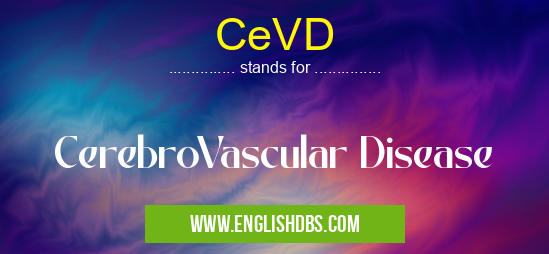What does CEVD mean in PHYSIOLOGY
Cerebrovascular Disease (CeVD) is a type of vascular disease that affects the arteries and veins in the brain, resulting in decreased blood flow to the brain. CeVD can lead to strokes, mini-strokes, or a transient ischemic attack (TIA). It is most commonly seen in adults with a history of hypertension, diabetes mellitus, atrial fibrillation or family history of stroke. The goal of treatment focuses on prevention and lifestyle changes to reduce the risk of further complications from CeVD.

CeVD meaning in Physiology in Medical
CeVD mostly used in an acronym Physiology in Category Medical that means CerebroVascular Disease
Shorthand: CeVD,
Full Form: CerebroVascular Disease
For more information of "CerebroVascular Disease", see the section below.
» Medical » Physiology
What is CeVD?
Cerebrovascular Disease (CeVD) is any form of damage or injury to the cerebrovascular system - an intricate network of vessels that carry blood from and to the brain. These vessels include arteries and veins which can become blocked, narrowed, weakened or bleeding due to various conditions like hypertension, diabetes mellitus and atrial fibrillation as mentioned earlier. In some cases it could also be hereditary or caused by head injuries or exposure to certain chemicals like drugs or environmental pollutants. Common symptoms include impaired vision, headaches, nausea and fatigue as well as reduced cognitive functions associated with memory problems and difficulty speaking.
Treatment for CeVD
The primary goal for treating Cerebrovascular Disease (CeVD) is prevention of further complications by making necessary lifestyle changes such as reducing risk factors like smoking and alcohol consumption, controlling existing medical conditions such as high cholesterol and diabetes and maintaining healthy habits suchas regular physical exerciseand diet control. Moreover, medications may be prescribed depending upon individual cases including anticoagulants or anti-platelet agents which help stop blood clot formation while aspirin might also be used along with other medications for acute stroke treatment when administered within 24 hours after onset of symptoms. Surgery may also be recommended in case of very severe cases where endarterectomy may help remove blockages from major vessels supplying blood to the brain.
Essential Questions and Answers on CerebroVascular Disease in "MEDICAL»PHYSIOLOGY"
What is CerebroVascular Disease?
CerebroVascular Disease (CeVD) is a medical condition that affects the vascular structures of the brain, such as blood vessels and arteries. It can include stroke, hemorrhage, and other forms of cerebrovascular diseases.
What causes CeVD?
The exact cause of CeVD is unknown, however there are certain risk factors which may contribute to its development, including hypertension, diabetes mellitus, smoking, and high cholesterol. Other contributing factors can include family history of stroke or cerebrovascular diseases.
What are the symptoms of CeVD?
Symptoms can vary depending on the type of CeVD present and may include weakness or paralysis on one side of the body, vision changes or loss of vision, difficulty speaking or understanding speech, headache, confusion or confusion with words or phrases. Other symptoms may also be present.
How is CeVD diagnosed?
In order to diagnose CeVD accurately, a physician will typically perform a variety of tests including imaging studies such as CT scan or MRI to look for any abnormal vascular structures in the brain and other neurological tests to assess any neurological impairment.
Can CeVD lead to stroke?
Yes, if left untreated it can lead to a stroke. A stroke occurs when an artery that supplies blood to part of your brain becomes blocked or bursts due to a weak spot in the wall of an artery. This blocks blood flow and deprives the affected area vital oxygen needed for proper functioning which leads to permanent damage if not treated quickly enough.
Are there any treatments available for CeVD?
Yes, depending on the severity there are treatments for this condition which may range from lifestyle changes such as controlling risk factors such as high blood pressure and quitting smoking to medications and surgery in severe cases.
Final Words:
In conclusion, Cerebrovascular Disease (CeVD) is a collection of diseases affecting the cerebrovascular system causing reduced blood flow supply to the brain leading to stroke or mini-stroke episodes as well as other cognitive issues. The primary goal for treating it lies in preventing further complications through lifestyle modifications like reducing risk factors and controlling existing medical conditions besides prescription medicines depending on individual case management while surgery may also be recommended in extreme cases.
